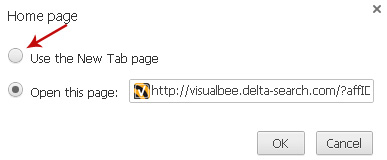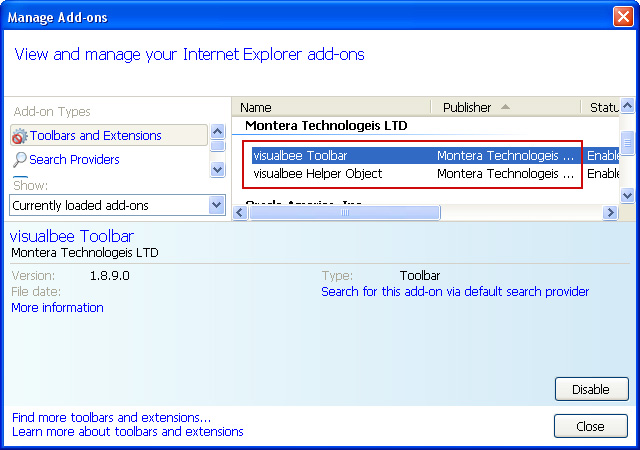Don't Copy From This Blog...
This page contains removal instructions for the VisualBee Toolbar and VisualBee Search engine. Please use this guide to remove VisualBee from Firefox, Chrome and Internet Explorer.Browser hijacking is both an irritation and a danger when using the internet these days and whether you’re being plagued by annoying pop-up adverts and windows or malicious software or coding which have taken over (i.e. hijacked) your browser, it’s probably safe to say that all of us have fallen victim to hijacking at some point in the not too distant past. While Visualbee advertises itself as a graphic designer for PowerPoint presentations some users think it's actually malware. Of course, it's not the same thing as spyware, trojans or rootkits. I would say browser hijackers can be fairly classified as potentially unwanted software.
But what is browser hijacking exactly and what will happen to you if you’ve been attacked? The term browser hijacking actually covers a number of different malwares - malicious software. Generally it is agreed by computer experts that browser hijacking software is an external code that changes your web browser settings, without either your knowledge or, in many cases, your permission. Most of the time, VisualBee gets installed along with other software. It can be really difficult to get rid of all references to VisualBee, so always "opt out" of any extras being installed.
When your settings have been changed you’ll no doubt then find that your home page has been changed too and that new favourite websites have been added to your desktop or favourites folder. In the majority of cases, these new ‘favourites’ will direct you to websites containing crappy content – which can be potentially embarrassing and difficult to explain to your significant other or your boss! Not only this but generally the hijacker will also have made system changes meaning that even if you change your computer settings back to your old home page, it will automatically revert back to the unwanted one. Typically, "VisualBee" appears on a new tab and redirects users to http://visaulbee.delta-search.com or search.conduit.com.
So how do browser hijackers install themselves on your computer in the first place, and what are the things you should be looking out for to limit the chances of it happening to you? In most cases a browser hijacker will exploit Microsoft Internet Explorer's ability to run ActiveX scripts directly from a web page. When used maliciously, you will often see a pop-up box which asks you if it can install itself on your PC. What you may not realise is that this is the hijacking program and should you give it the go ahead to install itself, Internet Explorer will then unwittingly execute the program – which then changes your settings.
In fact, the majority of browser hijacking programs will request your permission before installing anything – although this can be done in such a way that you don’t realise you’re giving them the right to install. For example if the ‘check box’ to give permission is already ticked, then you may be tricked into accepting is as you actually need to UN-tick the box to say yes, or vice versa. So, the lesson to be learned here is always read the small print in pop-up boxes and if a program requests permission to install itself on your computer while you are surfing the web, unless you are 100% sure what it is, always reject it. There are, however, many installers that will install VisualBee in Chrome and Firefox even when you opt-out it or cancel the installation.
Having said that, the really sneaky browser hijackers will further take advantage of security loop holes within web browsers and will install themselves completely without your knowledge.
Scary stuff but thankfully there are ways to avoid being hijacked providing that you take a few precautions. Read on and we’ll tell you how you can take steps to make sure the browser hijackers don’t get to you.
First things first and if you haven’t got anti-malware software installed on your computer you should do so right now (or as soon as you finish reading this article anyway!) Using a reputable anti-malware package will greatly diminish your chances of being hijacked by VisualBee, as will making sure that it is always up to date. You can also try using anti-malware 'auto protection' for further security. Consider keeping an anti-hijacking 'toolkit' handy for emergencies too – you can download one of these from the internet, the same way that you would with anti-malware software.
Changing your web browser security settings can help too – if your settings are set to their weakest you could be laying yourself open for attack.
Another thing to consider is changing your actual browser. Although you might really like Internet Explorer, or at least use it because it’s the one you’re ‘used to’ it might be worth considering stopping using it altogether. Because the majority of malware, spyware and browser hijacker programs are coded specifically for IE (thanks to the security lapses) switching browsers should stop them from affecting you, therefore it might be worth choosing an alternative such as Mozilla Firefox or Google Chrome. Even though, nowadays most browser hijackers works perfectly fine on all major web browsers but Firefox for example uses very strict rules to determine whether toolbars and search engines are malicious or not.
Finally, it may go without saying but use your common sense – don’t click on links in emails sent from someone who you don’t recognize and don’t click on pop-up ads or banners offering the latest ‘awesome’ free game, no matter how tempting it looks. If it’s too good to be true then it probably is.
To remove VisualBee toolbar and VisualBee Search, please follow the removal guide below. If you have any questions or comments, please leave a comment below. Good luck and be safe online!
Written by Michael Kaur, http://spywareremovalx.blogspot.com
VisualBee toolbar removal instructions:
1. First of all, download recommended anti-malware software and run a full system scan. It will detect and remove this infection from your computer. You may then follow the manual removal instructions below to remove the leftover traces of this browser hijacker. Hopefully you won't have to do that.
2. Uninstall VisualBee toolbar from your computer using the Add/Remove Programs control panel (Windows XP) or Uninstall a program control panel (Windows 7 and Windows 8).
Go to the Start Menu. Select Control Panel → Add/Remove Programs.
If you are using Windows Vista or Windows 7, select Control Panel → Uninstall a Program.

If you are using Windows 8, simply drag your mouse pointer to the right edge of the screen, select Search from the list and search for "control panel".

Or you can right-click on a bottom left hot corner (formerly known as the Start button) and select Control panel from there.

3. When the Add/Remove Programs or the Uninstall a Program screen is displayed, scroll through the list of currently installed programs and remove VisualBee toolbar application and also other applications you have recently installed.

Simply the application and click Remove. If you are using Windows Vista, Windows 7 or Windows 8, click Uninstall up near the top of that window. When you're done, please close the Control Panel screen.
Remove VisualBee from Google Chrome:
1. Click on Chrome menu button. Select Settings.
2. Click Set pages under the On startup.

Remove Visualbee Search by clicking the "X" mark as shown in the image below.

3. Click Show Home button under Appearance. Then click Change.

Select Use the New Tab page and click OK to save changes.

4. Click Manager search engines button under Search.

Select Google or any other search engine you like from the list and make it your default search engine provider.

Select VisualBee Search from the list and remove it by clicking the "X" mark as shown in the image below.

Remove VisualBee from Mozilla Firefox:
1. Open Mozilla Firefox. Go to Tools → Add-ons.

2. Select Extensions. Remove VisualBee toolbar extension. Close the window.

3. Click on the VisualBee Search search icon as shown in the image below and select Manage Search Engines....

4. Select VisualBee Search from the list and click Remove to remove it. Click OK to save changes.

5. In the URL address bar, type about:config and hit Enter.

Click I'll be careful, I promise! to continue.

In the search filter at the top, type: visualbee

Now, you should see all the preferences that were changed by VisualBee. Right-click on the preference and select Reset to restore default value. Reset all found preferences!

Remove VisualBee from Internet Explorer:
1. Open Internet Explorer. Go to Tools → Manage Add-ons.

2. Select Toolbars and Extensions. Remove visualbee toolbar and visualbee Helper Object Internet Explorer add-ons.

3. Select Search Providers. First of all, choose Live Search search engine and make it your default web search provider (Set as default).

4. Select VisualBee Search and click Remove to remove it. Close the window.





















0 comments:
Post a Comment